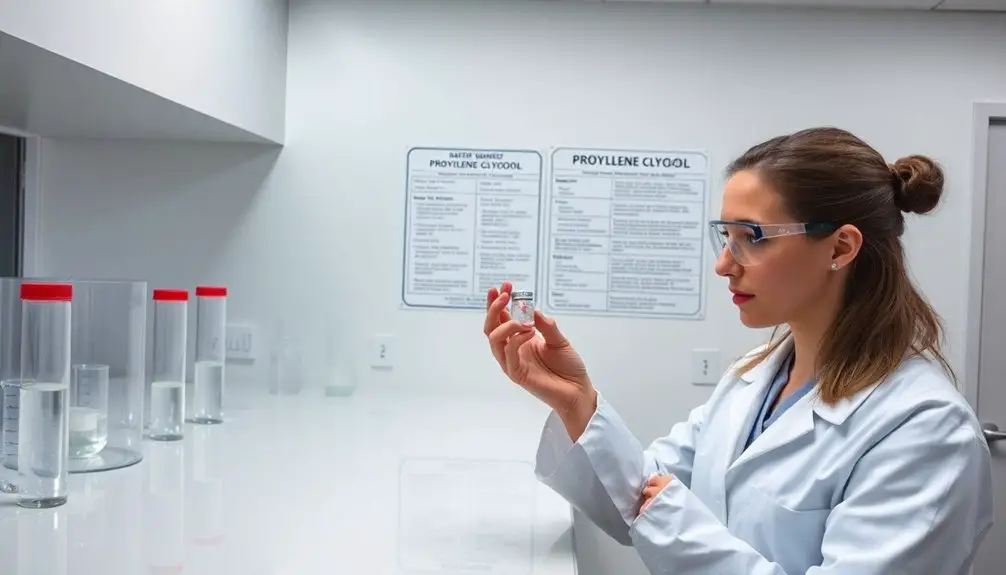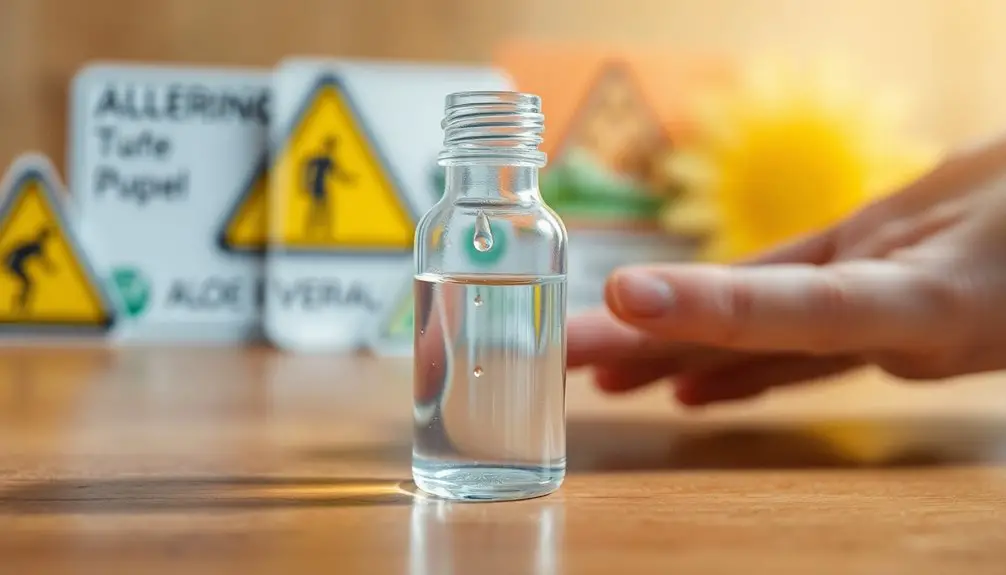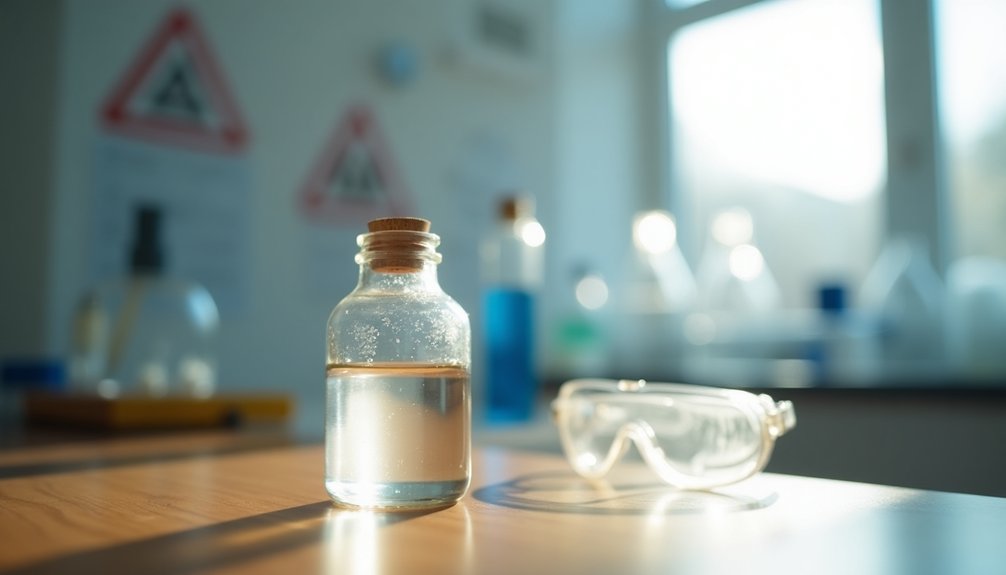Propylene glycol is classified as Generally Recognized As Safe (GRAS) by the FDA, with an acceptable daily intake set at 23 mg/kg of body weight for ages 2 to 65. The World Health Organization allows a slightly higher limit of 25 mg/kg. It's low in toxicity and commonly found in foods, medications, and cosmetics. However, if you have liver or kidney issues, or are pregnant, you should be cautious, as these groups are at higher risk. Always check labels to avoid excessive exposure. Want to find out more about specific risks and alternatives?
Key Takeaways
- The FDA classifies propylene glycol as Generally Recognized As Safe (GRAS) with an acceptable daily intake of 23 mg/kg body weight for ages 2 to 65.
- The World Health Organization (WHO) guideline sets a maximum daily intake of 25 mg/kg for propylene glycol.
- Approximately 45% of ingested propylene glycol is excreted unchanged by the kidneys, indicating low toxicity for most individuals.
- Vulnerable populations, such as pregnant women, infants, and those with liver or kidney impairments, should consult healthcare professionals regarding safe exposure levels.
- Monitoring labels for propylene glycol and its aliases is crucial to avoid allergic reactions or excessive intake.
Definition and Properties of Propylene Glycol
Propylene glycol is a synthetic food additive with the chemical formula C3H8O2, and it's a clear, colorless, and odorless liquid that's slightly thicker than water. Known for its unique properties, propylene glycol is hygroscopic, meaning it can retain moisture effectively. This characteristic makes it an excellent solvent, allowing it to dissolve various substances more efficiently than water.
You'll find propylene glycol commonly used in food products, medications, and cosmetics. Its low toxicity makes it a preferred choice, as it's classified as Generally Recognized As Safe (GRAS) by the FDA for consumption. Unlike ethylene glycol, which is toxic, propylene glycol poses minimal health risks when used appropriately.
In addition to being a food additive, it's often employed as a humectant and preservative, helping to maintain moisture content and extend shelf life.
As you explore products containing propylene glycol, you can feel confident in its safety profile. Understanding these properties helps you appreciate why it's widely utilized across various applications, making it a valuable ingredient in many everyday products.
Uses in Food and Cosmetics
In a variety of processed foods and cosmetics, propylene glycol plays a crucial role as both a humectant and preservative. In food products, it helps retain moisture and prevents clumping, ensuring your snacks and meals maintain their texture and taste.
The FDA recognizes propylene glycol as Generally Recognized As Safe (GRAS), with a daily intake limit of 23 mg/kg body weight for individuals aged 2 to 65.
In cosmetic products, propylene glycol acts as a solvent and preservative, enhancing the consistency and effectiveness of lotions, shampoos, and lipsticks. Its moisturizing properties help keep your skin hydrated and improve the penetration of active ingredients, making your beauty routine more effective.
Despite its widespread use, it's essential to be aware that some individuals may experience allergic reactions or skin irritations from products containing propylene glycol. If you have sensitive skin or specific skin conditions, it's wise to perform a patch test before fully incorporating these products into your routine.
Safety Assessments and Health Guidelines

Safety assessments surrounding propylene glycol highlight its low toxicity and general safety for consumption. The FDA classifies it as Generally Recognized As Safe (GRAS), recommending an acceptable daily intake of up to 23 mg/kg body weight for individuals aged 2 to 65.
Furthermore, the World Health Organization (WHO) has set a maximum intake guideline of 25 mg/kg body weight daily, indicating a strong safety threshold for everyday use.
Approximately 45% of ingested propylene glycol is excreted unchanged by the kidneys, showcasing its effective elimination from the body. Studies confirm that propylene glycol isn't linked to cancer or reproductive issues, reinforcing its reputation for propylene glycol safety.
With a median lethal dose in rats comparable to common substances like sugar, the overall risk remains low.
Regulatory agencies continuously monitor propylene glycol for long-term safety, ensuring that adverse effects are primarily associated with excessive doses rather than typical dietary exposure.
Following established health guidelines will allow you to enjoy the benefits of propylene glycol without concern, knowing that its safety assessments support its use in food and cosmetics.
Risks for Vulnerable Populations
Certain groups of people may face heightened risks when exposed to propylene glycol, particularly those with pre-existing health conditions.
If you have impaired liver or kidney function, your body might struggle to metabolize and excrete propylene glycol effectively, increasing the chances of propylene glycol poisoning. Pregnant women and infants are also at significant risk due to their lower levels of alcohol dehydrogenase, which heightens sensitivity to this compound.
High doses of propylene glycol in medications can pose significant risks for critically ill patients who may have compromised organ function.
Case reports have documented seizures in premature infants from high doses of vitamins containing propylene glycol, underscoring the need for caution in this population.
If you belong to any of these vulnerable groups, it's crucial to avoid products containing propylene glycol to mitigate health risks.
Always consult healthcare professionals if you have existing health conditions before using products that may contain this compound.
Being proactive about your health can help you steer clear of potential toxicity and other serious complications related to propylene glycol exposure.
Allergic Reactions and Avoidance Strategies

Experiencing allergic reactions to propylene glycol can be concerning, especially for those sensitive to this compound. To help you navigate this issue, consider these avoidance strategies:
- Check the Labels: Always read ingredient lists for propylene glycol and its aliases (like E1520) in processed foods and personal care products.
- Monitor Exposure: Be vigilant about your exposure levels, as even small amounts can trigger skin allergies or more severe reactions.
- Adopt a Whole Foods Diet: By focusing on whole foods, you'll reduce the likelihood of consuming propylene glycol, which is prevalent in packaged items.
- Consult Healthcare Providers: If you have known allergies, discuss your options with healthcare providers to find medications that don't contain propylene glycol.
Being proactive in these areas can significantly minimize allergic reactions.
Remember, a little awareness goes a long way in managing your health. If you notice any skin allergies or unusual symptoms after exposure, don't hesitate to seek medical advice.
Staying informed and cautious will help you live comfortably and safely, even if you have a sensitivity to propylene glycol.
Frequently Asked Questions
How Much Propylene Glycol Is Safe?
You should aim for a daily intake of propylene glycol around 23 to 25 mg per kilogram of your body weight. Staying within these limits helps ensure you're consuming it safely without any adverse effects.
What Is a Safe Concentration of Propylene Glycol?
A safe concentration of propylene glycol typically remains at or below 50%. You can find it in various products, knowing regulatory bodies endorse its use for food and cosmetics, ensuring it's safe for daily exposure.
How Much Propylene Glycol Is Allowed in Food?
The allowed amount of propylene glycol in food varies by regulations. Generally, you'll find it used as a food additive, but always check specific guidelines to ensure it meets safety standards for consumption.
What Is the Permissible Exposure Limit for Propylene Glycol?
You should know that permissible exposure limits for propylene glycol can vary by country and application. Generally, regulatory bodies set these limits based on safety assessments, ensuring you're protected from any potential health risks.

